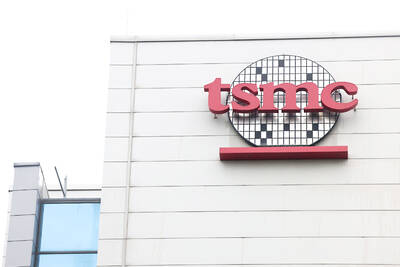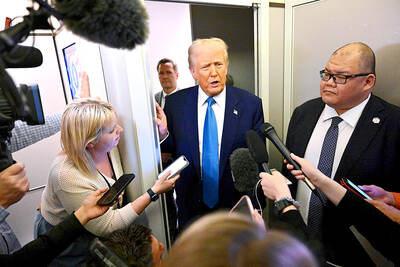Outbound investments approved by the Department of Investment Review, excluding those to China, soared 201 percent year-on-year to US$33.67 billion in the first eight months of this year, as companies push forward global supply chain realignment, the Ministry of Economic Affairs said on Monday.
The increase was mainly driven by Taiwan Semiconductor Manufacturing Co’s (台積電) US$5.26 billion investment in its Japanese subsidiary and US$5 billion investment in its US unit, as well as Vanguard International Semiconductor Corp’s (世界先進) investment of US$2.4 billion in its Singaporean joint venture with NXP Semiconductor NV, the ministry said in a statement.
WT Microelectronics Co’s (文曄科技) US$3.98 billion investment to acquire a 100 percent stake in Canadian electronic components distributor Future Electronics Inc also boosted outbound investments in the first eight months, the ministry added.

Photo: Taipei Times
As companies continue to diversify their supply chains and reduce their dependence on China, approved investments to countries covered by the government’s New Southbound Policy surged 155.96 percent year-on-year to US$7.72 billion in the eight-month period, it said.
The government introduced the policy in 2016 to enhance trade and exchanges with 18 nations in Southeast Asia, South Asia and Oceania, including Singapore, Vietnam and Malaysia — the top three destinations for Taiwanese investors in the first eight months of this year, it said.
Major New Southbound Policy investments during the period included Vanguard International’s investment in Singapore, Siliconware Precision Industries Co’s (矽品精密) US$270 million capital injection into its Malaysian subsidiary, Taipei Fubon Commercial Bank’s (台北富邦銀行) investment of US$173 million in its branch in Ho Chi Minh City and Lite-On Technology Corp’s (光寶科技) US$120 million investment in its Vietnamese unit, the ministry said.
Meanwhile, outbound investments to China rose 32.41 percent to US$3.16 billion during the first eight months, thanks to investments by Formosa Plastics Corp (台塑), Formosa Heavy Industry Corp (台朔重工), Hon Hai Precision Industry Co (鴻海精密), AUO Corp (友達光電) and Asia Cement Corp (亞洲水泥), it said.
Foreign direct investment approved by the department totaled US$5.36 billion in the first eight months, down 29.45 percent from the same period last year, the ministry said, attributing it in part to a high comparison base the previous year.
Over the same period, approved foreign direct investment from New Southbound Policy countries fell 56.92 percent annually to US$321.5 million, while those from China dropped 29.81 percent to S$16.8 million, it said.

When an apartment comes up for rent in Germany’s big cities, hundreds of prospective tenants often queue down the street to view it, but the acute shortage of affordable housing is getting scant attention ahead of today’s snap general election. “Housing is one of the main problems for people, but nobody talks about it, nobody takes it seriously,” said Andreas Ibel, president of Build Europe, an association representing housing developers. Migration and the sluggish economy top the list of voters’ concerns, but analysts say housing policy fails to break through as returns on investment take time to register, making the

‘SILVER LINING’: Although the news caused TSMC to fall on the local market, an analyst said that as tariffs are not set to go into effect until April, there is still time for negotiations US President Donald Trump on Tuesday said that he would likely impose tariffs on semiconductor, automobile and pharmaceutical imports of about 25 percent, with an announcement coming as soon as April 2 in a move that would represent a dramatic widening of the US leader’s trade war. “I probably will tell you that on April 2, but it’ll be in the neighborhood of 25 percent,” Trump told reporters at his Mar-a-Lago club when asked about his plan for auto tariffs. Asked about similar levies on pharmaceutical drugs and semiconductors, the president said that “it’ll be 25 percent and higher, and it’ll

NOT TO WORRY: Some people are concerned funds might continue moving out of the country, but the central bank said financial account outflows are not unusual in Taiwan Taiwan’s outbound investments hit a new high last year due to investments made by contract chipmaker Taiwan Semiconductor Manufacturing Co (TSMC, 台積電) and other major manufacturers to boost global expansion, the central bank said on Thursday. The net increase in outbound investments last year reached a record US$21.05 billion, while the net increase in outbound investments by Taiwanese residents reached a record US$31.98 billion, central bank data showed. Chen Fei-wen (陳斐紋), deputy director of the central bank’s Department of Economic Research, said the increase was largely due to TSMC’s efforts to expand production in the US and Japan. Investments by Vanguard International

WARNING SHOT: The US president has threatened to impose 25 percent tariffs on all imported vehicles, and similar or higher duties on pharmaceuticals and semiconductors US President Donald Trump on Wednesday suggested that a trade deal with China was “possible” — a key target in the US leader’s tariffs policy. The US in 2020 had already agreed to “a great trade deal with China” and a new deal was “possible,” Trump said. Trump said he expected Chinese President Xi Jinping (習近平) to visit the US, without giving a timeline for his trip. Trump also said that he was talking to China about TikTok, as the US seeks to broker a sale of the popular app owned by Chinese firm ByteDance Ltd (字節跳動). Trump last week said that he had